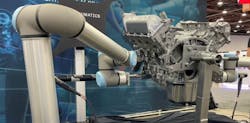A typical requirement of many robotic assembly applications involves delivery of a component to be assembled in a precise, fixed manner. Of course, there have been numerous developments over the past few years that enable robots to more flexibly complete assembly operations if the component is not delivered exactly to specifications, typically using machine vision systems to detect the position of the incorrectly delivered component to help the robotic system adapt.
Now, Humatics is taking flexible robotic assembly operations several steps further by enabling robots to perform assembly operations as the component moves through the assembly area without stopping. In addition, the system enables robots to adapt to the component’s motion if it moves around during assembly.
The technology uses radio frequency microlocation technology to do this. The company says the use of radio frequency communications allows the Humatics system to work well in industrial manufacturing environments with varying light conditions that could negatively impact use of machine vision tech for similar applications.
A demonstration of the technology at Automate 2023 showed how Humatics microlocation can be used to direct two robotic systems from Universal Robots with Atlas Copco end effectors to work concurrently on an engine as it moves through an assembly area. The robotic arms are guided by the Humatics system with sub-millimeter precision to achieve real-time, fine grain control for in-motion bolt torquing.
As seen in the video below, Ron Ranaldi, senior vice president of sales and marketing at Humatics, explained how the Humatics technology allows manufacturers to use robotic systems for in-motion assembly.
“Even as the engine moves in multiple directions, the microlocation system can guide the robot arm to the exact locations of the bolts as they move through the assembly area,” he said, while the engine swayed slightly as the bolts were torqued.
A key aspect of Humatics’ technology is its patented Base Station, which transmits and receives positional radio frequency signals. Components of the Humatics system can be integrated into existing equipment and the Base Station can be configured as needed for different applications. The Base Station includes integrated power but it can also be powered with a remote battery or connected to an external power source.
Advanced algorithms employed by Humatics deliver high-fidelity data that enable the precise movements around and interactions with the piece to be assembled. The system’s real-time position data can be sent to any PLC, robot controller or even order fulfillment systems, according to Humatics. This system agnosticism also allows manufacturers to use disparate robotic systems in their assembly operations.
Beyond robotic assembly, the data capabilities of the Humatics system can also be used for ongoing productivity analyses, as part of a production system of record and for quality control.
In the video, below Ron Ranaldi explains how the Humatics technology works in the Automate 2023 demonstration.
Leaders relevant to this article:


